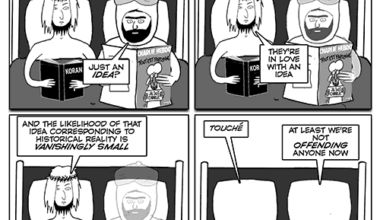
‘I’m offended by that….’ was the startled response I got from a fellow teacher. I’d raised concern in a department meeting. A student had been coming to school with her face concealed behind a niqab. I said that children shouldn’t have their faces covered in school.
Eyebrows were raised. Lips were pursed.
‘So…. Anyway…’
The ‘discussion’ was over.
I couldn’t help a final retort… ‘Be offended, then. It will do you some good.’
Admittedly conceited – and childish – I was sincere. I wanted my colleague, with whom I normally had an excellent relationship, to ‘feel’ the sharp jab of offence and consider, really, what had spurned it. After all, pain is so often a precursor to change, or at least to reflection – I hoped.
It was October, and for a month, a new, 16-year-old Year 12 student of Bengali heritage had been coming to our east London school wearing niqab – an Islamic face covering. She was a new student. Nobody had ever seen her face. She just arrived wearing it. Nobody said anything. We prided ourselves at this school, a recently established free school in east London, on our reflective, progressive ethos. Yet as far as this student’s approach was concerned, any sense of reflection or progress was hard to find.
I raised my concerns. On a practical, safeguarding level alone, it was a worry. How could the school know the student was who they claimed to be? Sixth formers have branded uniforms and carry photo identity cards for a reason. Then, of course, there’s the ethical quagmire around the whole ‘covering of women’ issue.
‘Just get over it. It’s their culture,’ I was told by a colleague.
‘Whose culture, exactly? Niqabs are a Gulf tradition and about as Bengali as the didgeridoo. And we don’t have a problem policing “culture” when it comes to the fashion choices of other minorities’ – is what I would have responded, had the conversation been allowed.
Meanwhile, other students were starting to follow suit. A handful of girls – all of Bengali heritage – were now coming in to school in niqab. For some reason, it seemed to be fine for them to do so intermittently: some days a student in my Year 12 English Literature class would wear a niqab, other days she wouldn’t. On the days when she did, her height and voice were the only ways I could identify her. She was quiet and of average size, so I couldn’t be certain who she was on the days that she did come in covered. My go-to approach was by process of elimination via the class register, which didn’t seem satisfactory or safe.
Then the Muslim boys, in disobedience of the school dress code, started to come in to school in thobe – long gowns traditionally worn by Muslim men. The school’s management team buried their heads deeper in the sand. Apparently, Muslim students could bend the rules, while others would get detentions for wearing trainers or donning ‘sculpted’ haircuts.
Any time I brought up this Islamic exceptionalism, papers were shuffled, eyes were averted and excuses made. Being of part-Bengali heritage myself gave me a certain latitude to be franker than others, but the mostly white, middle class staff room – normally a cacophony of ‘decolonising the curriculum’, ‘white privilege’ and ‘women’s rights’ – was silent on this issue, even though it blatently involved privileging one group of students over the rest.
And we all know why.
For the same reason I have to write this article under a pseudonym. The same reason a Yorkshire teacher and his family are still in hiding after showing the wrong cartoons to his class. It is ‘Islamophobia’ in the literal sense: teachers and schools are scared of Islam. Batley Grammar, protests at the gates, online furore, death threats, Samuel Paty, being labelled by colleagues as ‘intolerant’, ‘racist’, ‘offensive’. Schools are terrified of doing the wrong thing – so we do nothing.
And the worst symptom of this fear? Silence. In order to counter the unresponsiveness of my colleagues, I contacted my Head and other senior management via email to outline my concerns. There was no reply. Eventually, when I encountered my Head in the staff room, he nervously agreed that the school needed to ‘have a conversation’ about these issues.
That was four years ago. Since then, the cultural stand-off has only become more entrenched. The Muslim students effectively wear what they want, leave lessons to pray when they want, separate themselves according to gender when they want. They excuse themselves – on cultural grounds – from assemblies celebrating ‘controversial’ topics such as Pride month. Classrooms are commandeered in break times as ‘safe spaces’ and ‘prayer rooms’, segregated by gender, ethnicity and religion.
The staff pat themselves on the back for their ‘tolerance’ while simultaneously wringing their hands when the same students express intolerance on issues such as women’s rights, homosexuality, censorship and evolution – which they often dismiss as being inappropriate, ‘Western colonial’ content. But still nobody wants to have a conversation about it. Or even to ask what kind of message we as a school send when one group of students is allowed to create its own dress codes, curate its own curriculum, crowbar its ideas on gender and sexuality into classrooms.
While there may be some merit to certain cultural accommodations, the fear and silence that surround the whole situation are the most worrying aspect of all. Teachers today cannot even talk about the repercussions of allowing one particular group to break the rules applicable to everyone else, for fear of causing ‘offence’. What hope do future generations have?









2 comments
This is a description of dhimmitude in action, submission to Islam. Two quotes put this in context.
First in an article on the Quranic Concept of War:
“The universalism of Islam, in its all-embracing creed, is imposed on the believers as a continuous process of warfare, psychological and political, if not strictly military. . . . The Jihad, accordingly, may be stated as a doctrine of a permanent state of war, not continuous fighting.” – Majid Khadduri
https://securitypolicylaw.syr.edu/wp-content/uploads/2013/03/MyersJoseph.Quranic-Concept-of-War.pdf
Second, the statement by the leader of the largest Muslim organisation in the world in the aftermath of Christchurch:
The truth, we recognise, is that jihadist doctrine, goals and strategy can be traced to specific tenets of orthodox, authoritative Islam and its historic practice. This includes those portions of Shariah that promote Islamic supremacy, encourage enmity towards non-Muslims and require the establishment of a caliphate. It is these elements – still taught by most Sunni and Shiite institutions – that constitute a summons to perpetual conflict.
https://www.telegraph.co.uk/news/2019/03/24/prevent-another-christchurch-islam-must-confront-attacks-name/
http://newageislam.com/current-affairs/yahya-cholil-staquf/how-can-muslims-and-non-muslims-together–prevent-another-atrocity-like-the-one-in-christchurch?/d/118127
In this article we can see the process of psychological warfare that is the result of the teaching of those “portions of Shariah that promote Islamic supremacy, encourage enmity towards non-Muslims” leading to a state of “perpetual conflict”.
The Muslim children are, it seems, no longer bound by school rules and discipline and in that way are superior to the authority of the school and the teachers.
The ECHR summed it up in this 2003 judgment summary:
“Noting that the Welfare Party had pledged to set up a regime based on sharia law, the Court found that sharia was incompatible with the fundamental principles of democracy as set forth in the Convention. It considered that “sharia, which faithfully reflects the dogmas and divine rules laid down by religion, is stable and invariable. Principles such as pluralism in the political sphere or the constant evolution of public freedoms have no place in it”. According to the Court, it was difficult to declare one’s respect for democracy and human rights while at the same time supporting a regime based on sharia, which clearly diverged from Convention values, particularly with regard to its criminal law and criminal procedure, its rules on the legal status of women and the way it intervened in all spheres of private and public life in accordance with religious precepts.” – Annual Report 2003
http://www.echr.coe.int/Documents/Annual_report_2003_ENG.pdf
That ruling also provides the start of a tool set for correcting the situation but it will require government action. These suggestions will provide a way forward BUT it will require pressure on the government and the media to start a discussion of that ECHR ruling.
My suggestions are:
Get the ECHR ruling that sharia is “incompatible with democracy and human rights” taught as a compulsory part of the curriculum in ALL schools.
This follow-up report adds considerable detail to the original judgement summary
http://www.assembly.coe.int/Committee/JUR/ajdoc282016.pdf
1. Ask the government to publish the data behind paragraph 6 of Council of Europe resolution 2253 that shows exactly which parts of sharia law contravene the human rights convention.
http://assembly.coe.int/nw/xml/XRef/Xref-XML2HTML-en.asp?fileid=25353
2. Get this statement of principle from the Council of Europe resolution(1804 – 2007) implemented via legislation with strong teeth:
“Nor may states allow the dissemination of religious principles which, if put into practice, would violate human rights.
If doubts exist in this respect, states must require religious leaders to take an unambiguous stand in favour of the precedence of human rights, as set forth in the European Convention on Human Rights, over any religious principle.”
https://pace.coe.int/en/files/17568/html
Muy interesante ¿alguna posibilidad de escribir un reportaje sobre esta cuesión? ¿conocer buenas practicas para navegar con estos desafíos?
Your email address will not be published. Comments are subject to our Community Guidelines. Required fields are marked *
Donate